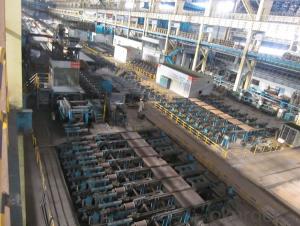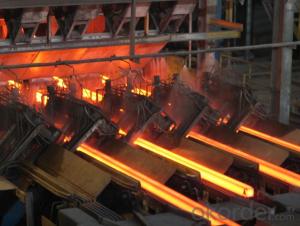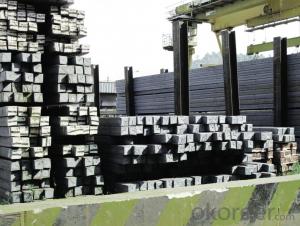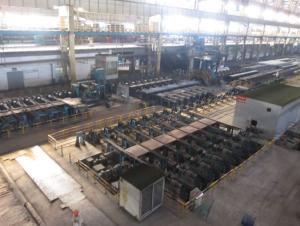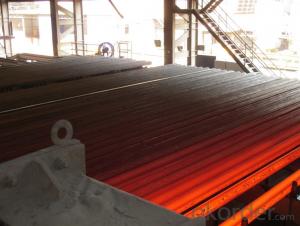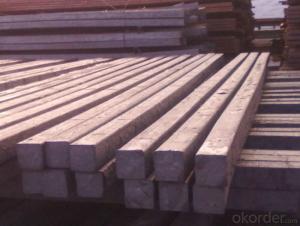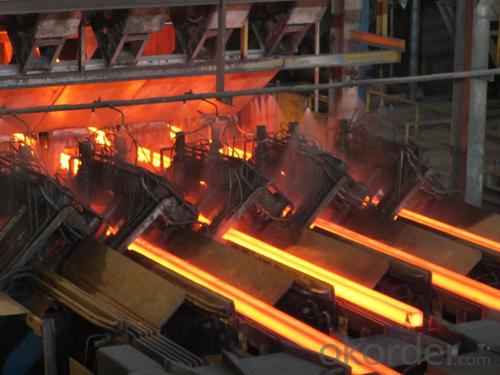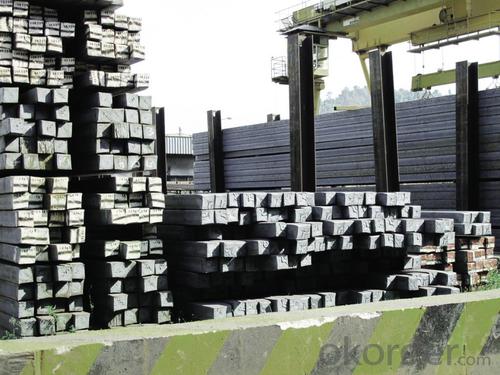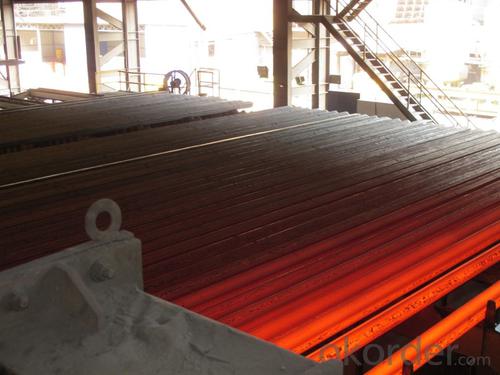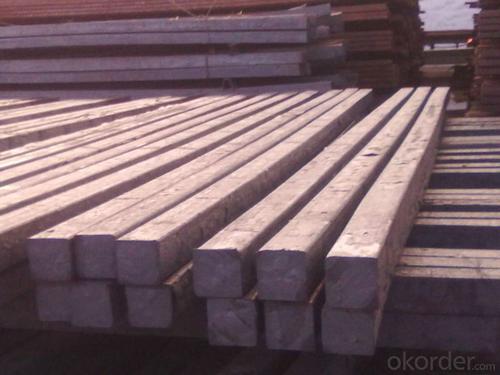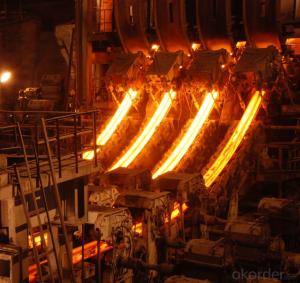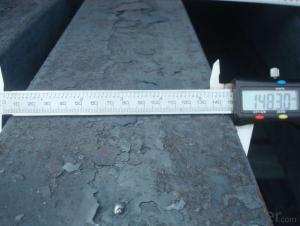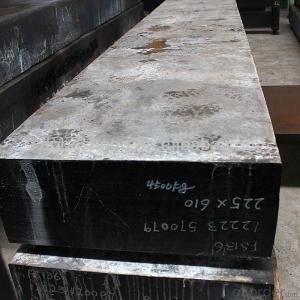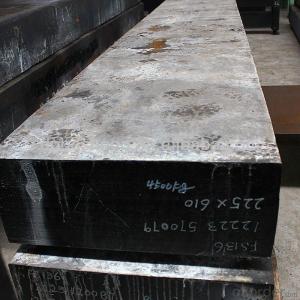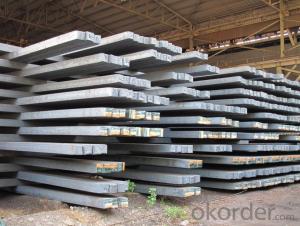Hot Rolled Steel Billet 3SP Standard 115mm
- Loading Port:
- Shanghai
- Payment Terms:
- TT OR LC
- Min Order Qty:
- 100 m.t.
- Supply Capability:
- 10000 m.t./month
OKorder Service Pledge
OKorder Financial Service
You Might Also Like
Structure of Hot Rolled Steel Billet 3SP Standard 115mm

Description of Hot Rolled Steel Billet 3SP Standard 115mm
Prepainted Rolled steel Coil is a kind of coated steel coil/sheet. With the cold rolled steel of different strength and thickness as substrate, it is produced through applying Al-Zn coat on both faces by hot dip process. In its coating, Al accounts for about 55%, Si 1.6%, while the remaining is Zn. Aluminum zinc coils enjoys both the physical protective feature and durability of Al and the electrochemical protective property of Zn. And its surface has bright silver color and regular embossed-like figure, which are highly decorative. RAL Scale Z35 Prepainted Rolled Steel Coil for Construction Roofing

Main Feature of Hot Rolled Steel Billet 3SP Standard 115mm
1.Corrosion resistance: It mainly depends on the zinc protection. When the zinc being worn,
2. Heat resistance: steel sheet has excellent heat resistance, can withstand high temperatures over 300 centigrade, and is similar with aluminized steel high temperature oxidation resistance. It often used in chimney pipes, ovens, fluorescent lighting device and the device cover.
3. Heat reflective: Galvanized steel plate heat-reflective high rate is twice as galvanized steel, often used to make insulation materials. RAL Scale Z35 Prepainted Rolled Steel Coil for Construction Roofing
Applications of Hot Rolled Steel Billet 3SP Standard 115mm
1. Construction and building: roofing; ventilating duct; handrail; partition panel;etc.
2. Electric appliance: refrigerator; washing machine; refrigerator; DVD;etc.
3.Transportation: oil tank; gas tank;road sign; etc.
4.Agriculture constructions :barn; etc.RAL Scale Z35 Prepainted Rolled Steel Coil for Construction Roofing
5.Others:vending machine; game machine; auto parts spare parts etc.
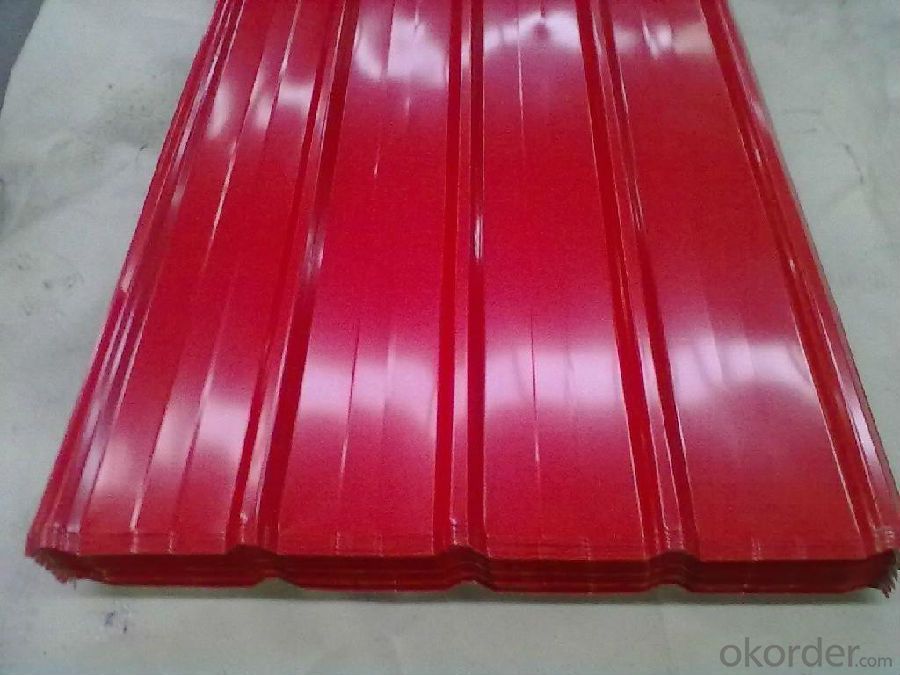
Specifications of Hot Rolled Steel Billet 3SP Standard 115mm
Product | Hot Rolled Steel Billet 3SP Standard 115mm |
Material Grade | SGCC / SGCH / DX51D+AZ, etc |
Thickness | 0.5-3.0mm |
Width | 700-1500mm |
Tolerance | Thickness: +/-0.02mm , Width:+/-2mm |
Zinc-coating | AZ30-150g/m2 |
Technique | Raw material: Hot rolled steel coil --> Cold rolled_>hot dipped galvalume |
Surface | Dried, Chromated, Unoiled,RAL Scale Z35 Prepainted Rolled Steel Coil for Construction Roofing |
Spangle | Regular spangle , small spangle, zero spangle |
ID | 508MM 610MM |
Coil weight | 25MT max |
Export package | Cardboard inner sleeves, Waterproof paper, galvanized steel covered and steel strip packed |
FAQ of Hot Rolled Steel Billet 3SP Standard 115mm
We have organized several common questions for our clients,may help you sincerely:
1. What is the minimum order quantity ?
Our MOQ is 100 mt for each size each specification. Usually we can offer discount if can buy large QTY once. RAL Scale Z35 Prepainted Rolled Steel Coil for Construction Roofing
2. How long can we receive the product after ordering?
Our general delivery time is 30 days after confirmation, but so some special orders, we have offer special delivery time
3. How to guarantee the quality of the products?
We have established the international advanced quality management system ,every link from raw material to final product we have strict quality test;We resolutely put an end to unqualified products flowing into the market. At the same time, we will provide necessary follow-up service assurance.
4. What is the payment?
We accept T/T, L/C
- Q: How are steel billets used in the manufacturing of automotive engine components?
- The production of automotive engine components heavily relies on steel billets, which are essential raw materials. These billets are semi-finished steel products, cast into specific shapes and sizes, acting as the foundation for various engine parts including crankshafts, connecting rods, camshafts, and cylinder blocks. To convert steel billets into engine components, a series of processes are undertaken. The initial step involves heating the billets to a high temperature, making them malleable and suitable for forging or machining. Forging, a commonly used technique, involves applying pressure and force to mold the billets into desired forms, like the curved shape of a crankshaft. Once the billets have been shaped through forging, further machining procedures are carried out to refine their dimensions and achieve the desired level of accuracy. Specialized machinery and tools are employed for drilling, milling, turning, and grinding. These machining processes are crucial in meeting the strict tolerances necessary for optimal performance and reliability of engine components. Steel billets are chosen for their exceptional properties, including strength, durability, and heat resistance. These attributes are of utmost importance for engine components, as they endure high pressures, temperatures, and loads during operation. The high tensile strength and ability of steel to withstand extreme conditions make it an ideal material for these critical parts. In conclusion, steel billets hold a significant role in the production of automotive engine components. Through forging and machining, they are transformed into precise and long-lasting parts that contribute to the smooth and efficient operation of engines. The use of steel billets guarantees the overall quality and performance of automotive engines, making them an integral part of the manufacturing process.
- Q: What are the different types of cutting processes used for shaping steel billets?
- There are several different types of cutting processes used for shaping steel billets. These processes include: 1. Bandsaw cutting: Bandsaw cutting is a widely used method for cutting steel billets. It involves using a continuous band of toothed metal blade to cut through the billet. Bandsaws are known for their ability to cut through thick sections of steel quickly and accurately. 2. Abrasive cutting: Abrasive cutting involves using an abrasive wheel or disc to cut through the steel billet. This method is commonly used for cutting smaller billets or for cutting shapes and contours into the billet. Abrasive cutting is known for its versatility and ability to produce smooth and precise cuts. 3. Plasma cutting: Plasma cutting is a thermal cutting process that uses a high-velocity jet of ionized gas to melt and remove the steel from the billet. This method is often used for cutting thick sections of steel or for cutting intricate shapes. Plasma cutting is known for its speed and ability to produce clean cuts. 4. Waterjet cutting: Waterjet cutting is a process that uses a high-pressure jet of water to cut through the steel billet. In some cases, abrasive particles may be added to the water to enhance the cutting ability. Waterjet cutting is known for its ability to cut through thick sections of steel without creating heat-affected zones or distortion. 5. Laser cutting: Laser cutting involves using a high-powered laser beam to melt and vaporize the steel billet. The laser beam is guided by computer controls to cut the desired shape. Laser cutting is known for its precision and ability to cut intricate shapes with minimal distortion. These are just a few examples of the different types of cutting processes used for shaping steel billets. Each process has its own advantages and is chosen based on factors such as the size of the billet, the desired shape, and the required accuracy.
- Q: How are the surface defects of steel billets repaired?
- The surface defects of steel billets can be repaired through various methods, depending on the type and severity of the defect. Some common surface defects include cracks, seams, laps, and scale. One method of repairing surface defects is through grinding or milling. This involves removing the surface layer of the billet using abrasive tools or machines. Grinding can effectively eliminate small defects such as scale, pits, or minor cracks. However, it may not be suitable for deep or extensive defects. For more severe defects like cracks or seams, a common repair technique is welding. The damaged areas are preheated to a suitable temperature, and then the cracks or seams are filled using welding electrodes or filler materials. This process requires skilled welders to ensure proper fusion and strength of the repaired area. In some cases, surface defects can be repaired through mechanical methods such as peening or hammering. These techniques involve using specialized tools to reshape and smooth out the affected areas. Peening can be effective for eliminating shallow cracks or surface irregularities. Ultrasonic testing is another method used to identify and repair surface defects in steel billets. It involves using high-frequency sound waves to detect any hidden cracks or flaws. Once the defects are identified, appropriate repair methods can be employed. It is important to note that the repair process for surface defects in steel billets requires careful inspection and assessment to determine the most suitable method. Quality control measures must be put in place to ensure that the repaired billets meet the required standards for strength and integrity.
- Q: What is the typical surface finish of a steel billet?
- The typical surface finish of a steel billet can vary depending on the specific application and processing method. However, in general, steel billets are commonly produced with a surface finish that is relatively rough and may exhibit some imperfections such as scale, oxide layers, or minor surface irregularities. This is primarily due to the manufacturing process, which involves hot rolling or casting of the steel billet. Hot rolling is a common method used to produce steel billets. During this process, the steel is heated to high temperatures and passed through a series of rollers to shape it into the desired dimensions. This high-temperature process can result in the formation of scale or oxide layers on the surface of the billet. These layers can give the steel a rough and textured appearance. Similarly, steel billets produced through casting methods, such as continuous casting or ingot casting, may also exhibit a rough surface finish. In these processes, the molten steel is solidified in molds or ingot molds, which can result in the formation of surface imperfections such as surface cracks, pits, or uneven surfaces. However, it is important to note that the surface finish of steel billets can be improved through additional processes such as descaling, shot blasting, or grinding. These processes can help remove the scale, oxide layers, or other surface imperfections, resulting in a smoother and more uniform surface finish. Additionally, some steel billets intended for specific applications, such as precision machining or forging, may undergo additional surface treatments to achieve a desired finish, such as polishing or coating. Overall, the typical surface finish of a steel billet is relatively rough and may exhibit scale, oxide layers, or minor surface irregularities. However, various additional processes can be applied to improve the surface finish according to specific requirements and applications.
- Q: How are steel billets used in the manufacturing of industrial compressors?
- Steel billets are crucial in the manufacturing of industrial compressors as they serve as the raw material for forging or machining the various components of the compressors such as cylinders, pistons, and crankshafts. These billets are heated and shaped through different manufacturing processes to create the desired compressor parts, ensuring strength, durability, and high performance in the final product.
- Q: How are steel billets used in the production of turbine blades?
- Steel billets are an integral component in the production of turbine blades. These billets, which are essentially semi-finished steel products, serve as the starting material for the manufacturing process. To begin with, steel billets are carefully selected based on specific requirements such as composition, strength, and durability. Once chosen, they undergo a series of processing steps to shape them into turbine blades. The first step involves heating the steel billets to high temperatures in a furnace. This process, known as forging, makes the steel more malleable and easier to work with. Once heated, the billets are then subjected to mechanical forces that shape them into the desired form of turbine blades. After the initial forging process, the turbine blades are further refined through various machining operations. This includes precision cutting, grinding, and drilling to achieve the required dimensions, surface finish, and aerodynamic profiles. In addition to shaping and refining, steel billets also play a crucial role in enhancing the strength and integrity of turbine blades. Through heat treatment processes such as quenching and tempering, the billets are hardened and tempered to achieve the desired mechanical properties, such as high strength and resistance to fatigue. Furthermore, steel billets provide the necessary material properties to withstand the harsh operating conditions of turbines. They offer excellent corrosion resistance, which is essential for blades operating in environments exposed to high temperatures, pressure, and moisture. Overall, steel billets are essential in the production of turbine blades as they provide the starting material, allow for shaping and refinement, and offer the necessary strength and durability required for these critical components in power generation.
- Q: How are steel billets used in the production of industrial furnaces?
- Steel billets are used in the production of industrial furnaces as the primary raw material for constructing the furnace structure and components. These billets are melted and molded into various shapes and sizes to create the furnace body, walls, doors, and other necessary parts. The high strength and heat resistance of steel make it ideal for withstanding the extreme temperatures and harsh conditions within the furnace, ensuring its durability and longevity.
- Q: How do steel billets contribute to the manufacturing of agricultural equipment?
- Steel billets are a crucial component in the manufacturing of agricultural equipment due to their versatility and durability. These billets, which are essentially semi-finished steel products, serve as the foundation for various agricultural machinery and equipment. Firstly, steel billets are used to create the main structural components of agricultural equipment such as tractors, harvesters, plows, and tillers. These components, such as the chassis, frame, and axles, require a strong and sturdy material to withstand the heavy loads and harsh conditions encountered in agricultural operations. Steel billets provide the necessary strength and resilience to ensure the equipment can withstand the rigors of farming. In addition to the structural components, steel billets are also used to manufacture smaller parts and mechanisms that are integral to the functioning of agricultural machinery. For example, gears, sprockets, shafts, and bearings are commonly made from steel billets. These parts are essential for transmitting power and facilitating the smooth operation of various agricultural equipment. Moreover, steel billets contribute to the longevity and reliability of agricultural equipment. The high strength and durability of steel ensure that the machinery can withstand the demanding agricultural environment, including exposure to moisture, dirt, and extreme temperatures. This durability reduces maintenance requirements and extends the lifespan of the equipment, resulting in cost savings for farmers. Furthermore, steel billets can be easily shaped and molded into complex designs, allowing manufacturers to create customized agricultural equipment tailored to specific farming needs. This flexibility in design enables the production of specialized machinery for various agricultural operations, such as planting, harvesting, irrigation, and livestock management. Overall, steel billets play a vital role in the manufacturing of agricultural equipment by providing the necessary strength, durability, and versatility required for the demanding conditions of modern farming. Their contribution ensures that farmers have access to reliable and efficient machinery, ultimately increasing productivity and supporting sustainable agricultural practices.
- Q: What are the different surface defects that can be found in steel billets?
- Some common surface defects that can be found in steel billets include cracks, scale, pits, inclusions, and surface roughness.
- Q: What are the different shapes of steel billets?
- Steel billets can come in various shapes, including square, round, rectangular, and hexagonal.
Send your message to us
Hot Rolled Steel Billet 3SP Standard 115mm
- Loading Port:
- Shanghai
- Payment Terms:
- TT OR LC
- Min Order Qty:
- 100 m.t.
- Supply Capability:
- 10000 m.t./month
OKorder Service Pledge
OKorder Financial Service
Similar products
Hot products
Hot Searches
Related keywords
